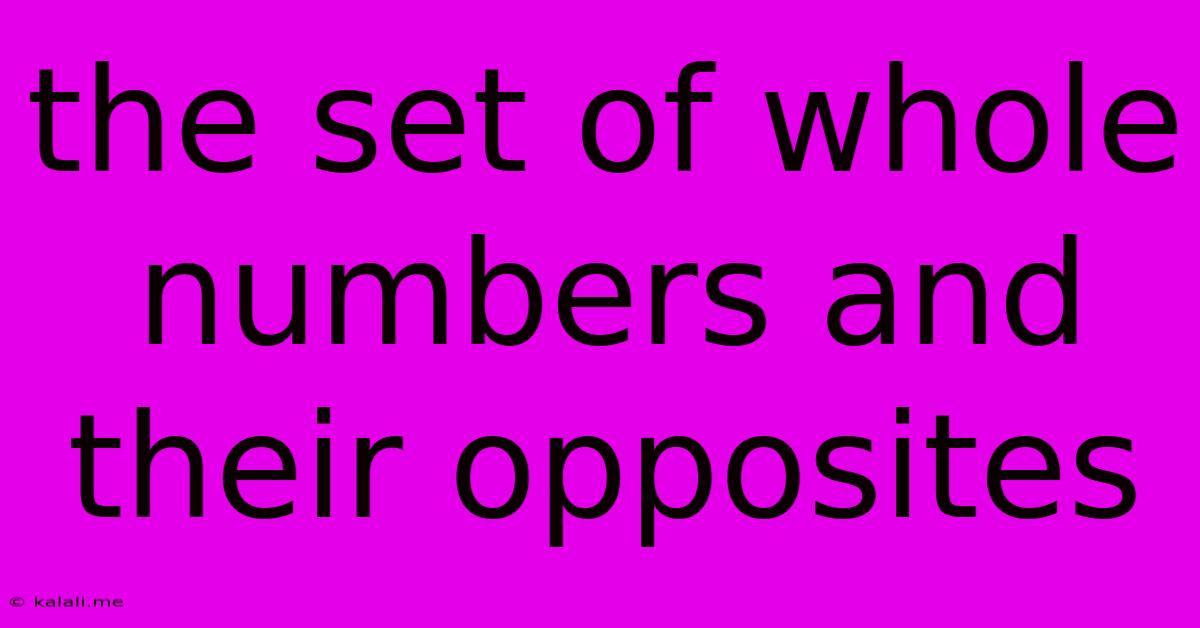The Set Of Whole Numbers And Their Opposites
Kalali
May 10, 2025 · 3 min read

Table of Contents
Exploring the Set of Whole Numbers and Their Opposites: A Deep Dive into Integers
The world of numbers is vast and fascinating, encompassing various sets with unique properties. This article delves into the set of whole numbers and their opposites, formally known as integers. Understanding integers is fundamental to grasping more complex mathematical concepts, from algebra to calculus. We'll explore their definition, representation, properties, and practical applications.
What are Whole Numbers?
Whole numbers are the foundation of our numerical system. They begin with zero and continue infinitely in a positive direction. This set can be represented as {0, 1, 2, 3, 4, 5,...}. Whole numbers are used for counting discrete objects and representing quantities. Think about counting apples, the number of cars in a parking lot, or the number of days in a week – these are all scenarios where whole numbers are naturally applied. They are also crucial for basic arithmetic operations like addition, subtraction, multiplication, and division (with the caveat of division not always resulting in a whole number).
Introducing Opposites: Negative Numbers
While whole numbers handle positive quantities, many real-world scenarios require representing values less than zero. This is where negative numbers come into play. The opposite of a whole number is simply its negative counterpart. For example, the opposite of 5 is -5, the opposite of 100 is -100, and the opposite of 0 is 0 (zero is its own opposite). These negative numbers extend the number line infinitely in the negative direction.
The Set of Integers: Combining Whole Numbers and Their Opposites
When we combine the set of whole numbers and their negative counterparts, we obtain the set of integers. This set is represented as {...,-3, -2, -1, 0, 1, 2, 3,...}. Integers are crucial for representing various concepts, including:
- Temperature: Measuring temperatures below zero degrees Celsius or Fahrenheit.
- Altitude: Representing elevations below sea level.
- Financial Transactions: Tracking debts and credits.
- Coordinate Systems: Defining points on a coordinate plane.
- Mathematical problem-solving: Solving equations and inequalities.
Visualizing Integers: The Number Line
A number line provides a visual representation of integers. Zero is positioned at the center, with positive integers extending to the right and negative integers extending to the left. This visualization helps understand the relative magnitudes and ordering of integers. It also helps illustrate concepts like absolute value (the distance of a number from zero) and comparing integers.
Operations with Integers
Performing arithmetic operations (addition, subtraction, multiplication, and division) with integers involves understanding the rules of signs. These rules ensure consistent and accurate results:
- Addition: Adding two positive integers results in a positive integer. Adding two negative integers results in a negative integer. Adding a positive and a negative integer requires considering their absolute values and signs.
- Subtraction: Subtracting an integer is equivalent to adding its opposite.
- Multiplication: Multiplying two integers with the same sign (both positive or both negative) results in a positive integer. Multiplying two integers with opposite signs results in a negative integer.
- Division: Similar rules apply to division as multiplication regarding the signs of the integers.
Conclusion: The Importance of Integers in Mathematics and Beyond
The set of integers, encompassing whole numbers and their opposites, is a fundamental building block of mathematics. Understanding integers and their properties is essential for progressing to more advanced mathematical concepts. Their applications extend far beyond the classroom, impacting various fields, from finance and engineering to science and technology. By mastering the concepts outlined here, you’ll build a stronger foundation for your mathematical journey.
Latest Posts
Latest Posts
-
How Much Is Three Quarts Of Water
Jul 03, 2025
-
How Tall Is A 3 Story Building
Jul 03, 2025
-
Is Miranda Cosgrove Related To Jimmy Fallon
Jul 03, 2025
-
What Is 1 4 Of A 1 4 Cup
Jul 03, 2025
-
What Is 20 Percent Off Of 39 99
Jul 03, 2025
Related Post
Thank you for visiting our website which covers about The Set Of Whole Numbers And Their Opposites . We hope the information provided has been useful to you. Feel free to contact us if you have any questions or need further assistance. See you next time and don't miss to bookmark.